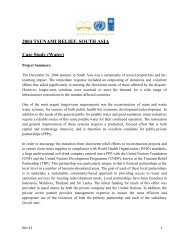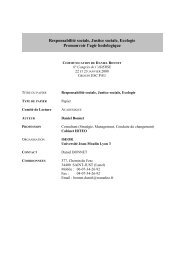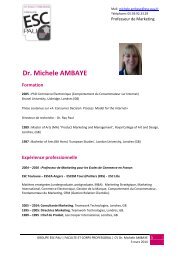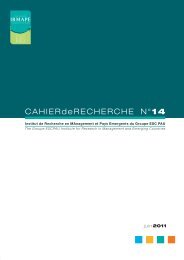UNION STATION, WASHINGTON, DC Case Study ... - ESC Pau
UNION STATION, WASHINGTON, DC Case Study ... - ESC Pau
UNION STATION, WASHINGTON, DC Case Study ... - ESC Pau
- No tags were found...
Create successful ePaper yourself
Turn your PDF publications into a flip-book with our unique Google optimized e-Paper software.
<strong>UNION</strong> <strong>STATION</strong>, <strong>WASHINGTON</strong>, <strong>DC</strong><strong>Case</strong> <strong>Study</strong> (Public Buildings and Transportation)Project Summary:At the time of its opening on October 27, 1907, Union Station was the largest train station in theworld and was a truly monumental example of Beaux-Arts architecture. By the late 1970s,however, the building was in a serious state of disrepair, was unoccupied and in danger ofdemolition. The Federal Government lacked funds to renovate or even maintain the station.Citizen groups and politicians began searching for an alternative approach. As a result, the U.S.Congress enacted the Redevelopment Act of 1981. Under the Redevelopment Act, the U.S.Department of Transportation (USDOT) took control of the project and began to transform thestation into a thriving transportation terminal and commercial center. Because of the costsinvolved in the restoration and the potential commercial economic benefits, a public-privatepartnership was immediately identified as the best tool to accomplish the restoration.The transformation process included the efforts of the USDOT, the District of Columbia citygovernment, Amtrak (The National Railroad Passenger Corporation, a quasigovernmental entity)and a private developer. The $160 million project took almost five years to complete, includingthree years of renovation. The project goals encompassed the authentic restoration of the originalarchitecture, the reintroduction of train and urban mass transit services and the addition of a widerange of retail, dining and entertainment options. As a result of a strong public-privatepartnership, Union Station has been restored to its original grandeur and utility and is now themost visited site in the city, with over 25 million visitors each year.Project Objectives:Prior to the decision to renovate it, costs to maintain the station had become overwhelminglyexpensive. Both the Federal and District governments wished to find a financially viable optionto fund the restoration of the station in order to create transportation hub, stimulate economicdevelopment in the area, and retain the historic quality of the Washington, <strong>DC</strong> landmark.Project Description:1. PartnersNov-12 1
The Union Station Redevelopment Corporation (Redevelopment Corporation), a nonprofit entity,was formed with the goal of finding private sector partners to complete the restoration processand selected private sector development partners through a national competition. The railwaycompanies using the terminal, both intercity and the regional mass transit systems, alsoparticipated. Ultimately, twelve state and federal agencies, each with varying levels ofjurisdiction over the project, and the private partners negotiated agreements that met eachagency's requirements and served the overarching goal of ensuring the station's long-termcommercial success.2. Implementation EnvironmentCongress wanted the station to be restored as the primary tourist and transportation center forWashington, <strong>DC</strong> and for the Federal government to withdraw from any active role in theoperation and management of Union Station as soon as practical. Furthermore, the project was tobe completed with the least possible Federal Expense. The project required careful coordinationof code compliance, historic preservation methods and retail principles.3. Financial AgreementThe $160 million restoration cost was derived from a combination of public and privatefinancing. Amtrak contributed $70 million to the refurbishment. The District of Columbiacontributed $40 million in surplus interstate highway funds. Finally, the private developerprovided the remaining balance through equity financing.In order to generate an ongoing income stream, the agreement stipulated that the privatedeveloper would pay a base rent (indexed for inflation) and profits from the operation of thestation would be shared by both the private developer and the Redevelopment Corporation.Finally, the funds provided by Amtrak would be repaid from the station's revenues.4. Contract ProvisionsAgreements for twelve state and federal agencies were developed and conflicts were resolvedthrough multi-party discussions. Memoranda of Agreement with each of these agenciesembodied concepts that allowed the design to proceed with a regular design review and a disputeresolution process. The final contract incorporated the needs of the transportation function of thestation and historic preservation, while enabling Union Station to become a commercially viableNov-12 2
operation. For instance, a significant component of making this project financially viable was theaddition of mezzanine levels in the station to create more commercial space in order to generatemore station revenue.5. Implementation MetricsThe Redevelopment Corporation was confident that the project would be successful if thecombination of traffic flow segments - intercity rail passengers, commuter rail customers,subway users, tour bus visitors and neighborhood residents - all came to the newly renovatedstation in large numbers. The renovation plan provided that the historic Main Hall be set aside asa restored space without commercial enterprises. The Concourse became the railroad's ticketingand baggage facility and was expanded into a three-level commercial retail center.A multi-deck, 1,500-space, public parking garage, a tour bus level capable of handling 80 buses,and a rail service waiting were added. More than 120 stores, restaurants, cafes and a nine screencinema were constructed providing over 210,000 square feet of retail space. Office space wasalso created, which accommodates Amtrak's 100,000 square foot national headquarters. The neteffect of these changes was to double the commercially-available space.Commentary:The successful collaboration of the public and private made the Union Restoration a triumph thatbenefits, not just the partners involved, but every visitor to the unique historic site. The publicprivatepartnership succeeded due to a combination of factors that included commitment on thepart of the political leadership to the project and public sector involvement throughout theproject. Moreover, the project followed a well-conceived, carefully executed plan that included adedicated income stream, open communication and dispute resolution channels and the rightprivate partner.The Union Station public-private partnership incorporated the building's transportation utilityand unique architectural aspects to create a functional commercial destination that attracts traintravelers, tourists and local customers alike and benefits the city of Washington, <strong>DC</strong>.Nov-12 3
















